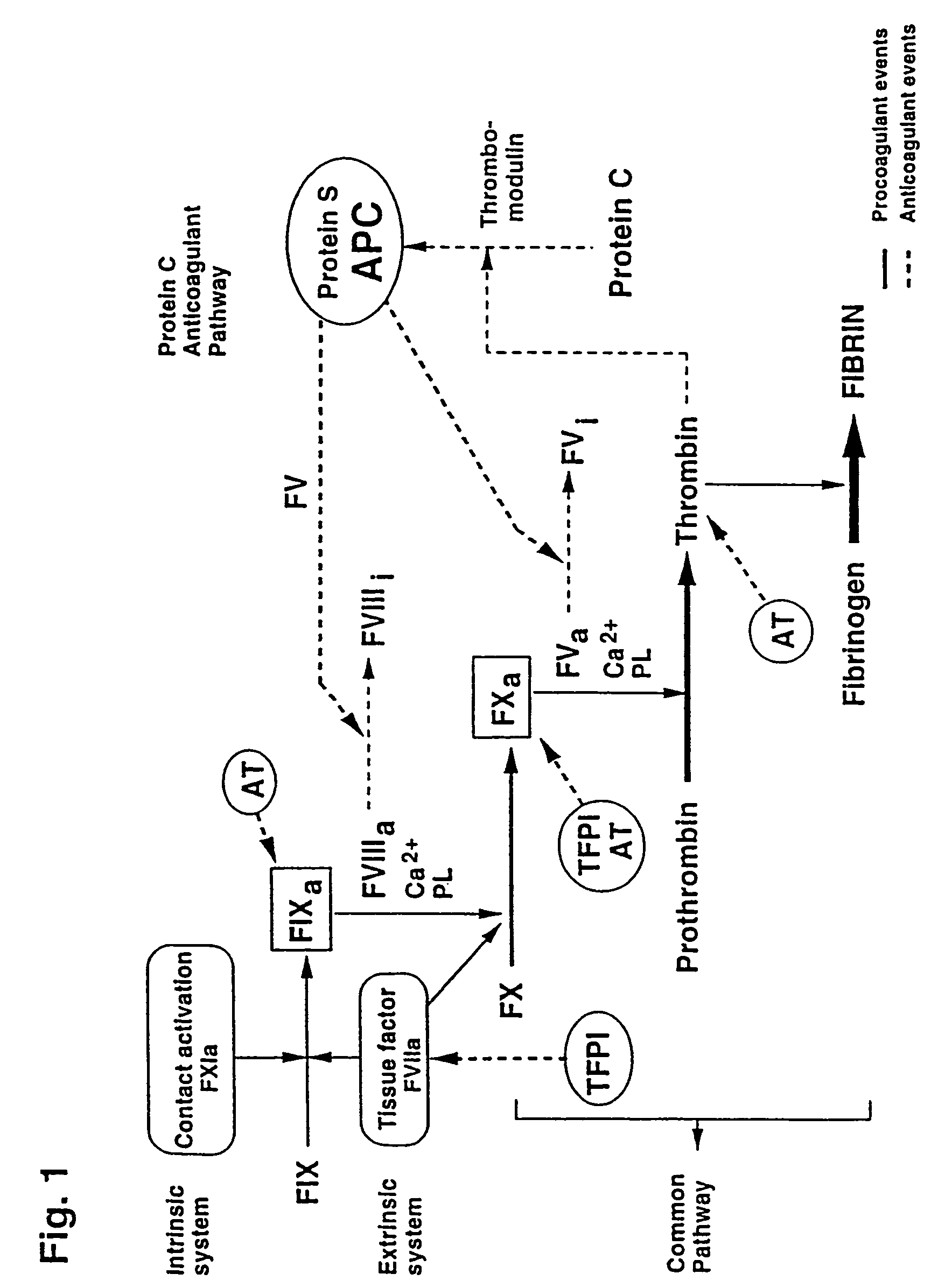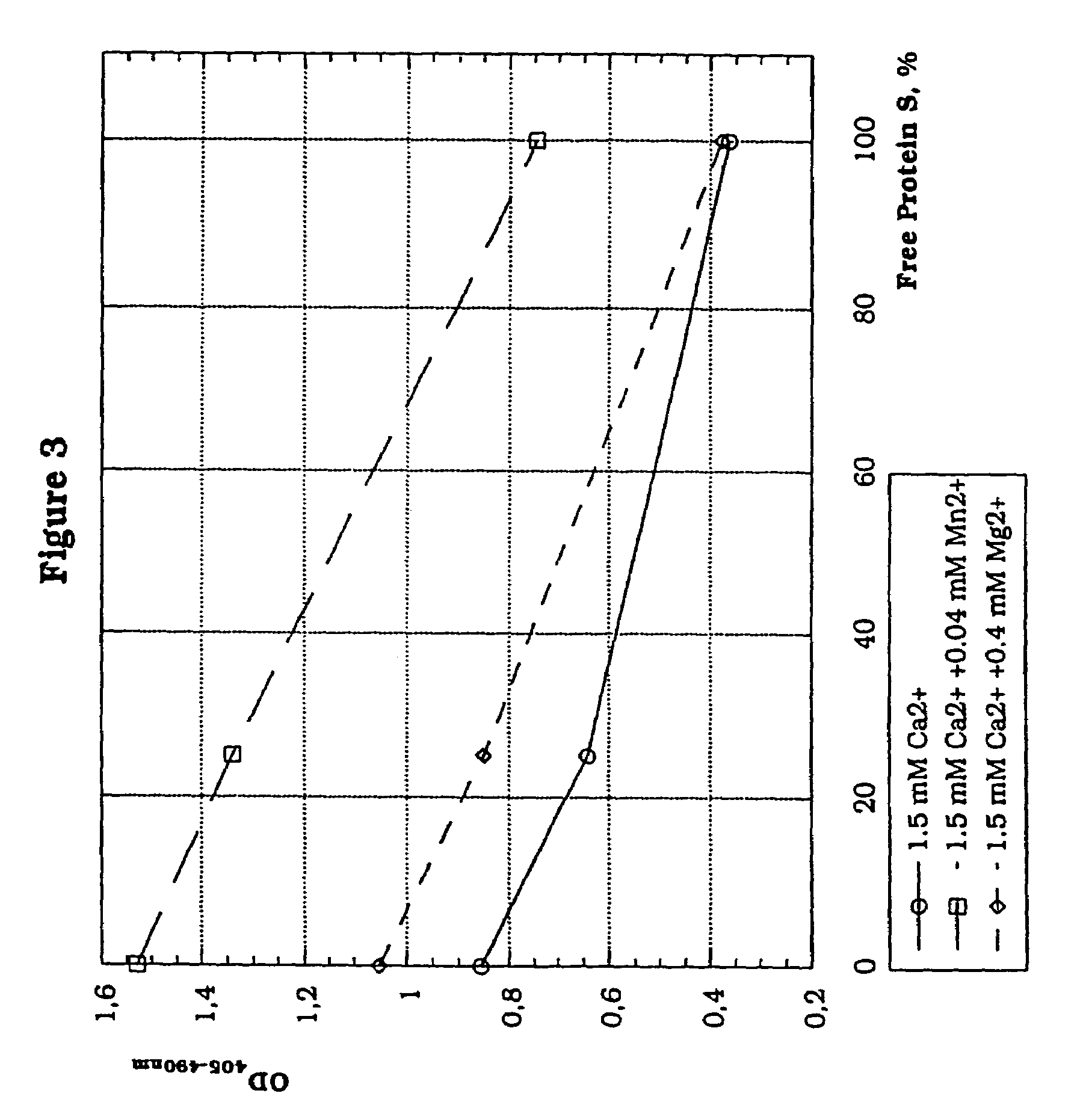Kits for screening for blood coagulation disorders
a technology for blood coagulation disorders and kits, which is applied in the direction of peptides, peptide/protein ingredients, peptide sources, etc., can solve the problems of limiting the general applicability of tests, lack of specificity of tests, and increase the risk of thrombosis, so as to improve the anticoagulant activity of proteins, high degree of discrimination, and high degree of resolution
- Summary
- Abstract
- Description
- Claims
- Application Information
AI Technical Summary
Benefits of technology
Problems solved by technology
Method used
Image
Examples
example 1
[0134]The effect of manganese and magnesium ions on the determination of Protein C activity in a three-stage, chromogenic, thrombin generation assay using the Protein C activator Protac® C was assessed as follows.
[0135]Samples: Protein C deficient plasma (Biopool AB, Ume{dot over (a)}, Sweden) with and without addition of purified human Protein C (Chromogenix AB) to yield 0, 0.1, 0.5 and 1.0 IU / mL of Protein C.
[0136]Sample dilution: 1:41 in 25 mmol / L Tris-HCl, pH 7.6, 20 mmol / L NaCl, 0.2% bovine serum albumin.
[0137]Protein C activator: Protac® C was used as a stock solution containing 10 U / mL. Final concentration during activation of Protein C=0.17 U / mL. Mg2+ and Mn2+ ions were added to yield final concentrations during activation of Protein C of 0.4 and 0.04 mmol / L, respectively.
[0138]Reagent 1:[0139]Bovine Factor IXa (Enzyme Research, South Bend, Ill.), 180 pmol / L[0140]Bovine FX (Chromogenix AB), 0.3 U / mL
[0141]Reagent 2:[0142]Phospholipids* (Chromogenix AB), 60 μmol / L[0143]Gly-Pro...
example 2
[0152]The effect of different metal ions on the determination of Protein C activity in a three-stage thrombin generation assay using a four-fold lower concentration of Protein C activator was assessed.
[0153]Experimental conditions are as in Example 1, except for the use of a final concentration of the Protein C activator (Protac® C) of 0.043 U / mL. Mg2+,Mn2+, Zn2+ and Ni2+ ions were added to yield final concentrations during activation of Protein C of 0.4 mmol / L (Mg2+) or 0.04 mmol / L. Zn2+ ions, Mn2+ ions and Cu2+ ions were also added to yield a final concentration of 0.08 mmol / L. Ca2+ was also used at final concentrations of 1.5 mmol / L and 6.6 mmol / L in the absence of other metal ions.
[0154]Results: The results are shown in the table below with all primary data, which also includes a comparison between final concentrations of 0.04 and 0.08 mmol / L for Mn2+ and Zn2+.
[0155]
Protein C, IU / mLIons00.10.51.0Ca2+, 6 mmol / L0.6520.6330.5590.505Ca2+, 1.5 mmol / L0.6400.5850.5040.438Ca2+, 1.5 mmol...
example 3
[0157]The effect of metal ions on the determination of Protein C activity in a two-stage thrombin generation assay was assessed.
[0158]These experimental details are as described in Example 1, with the following exceptions:
[0159](a) the final concentration of the Protein C activator (Protac® C) was 0.043 U / mL during activation of Protein C,
[0160](b) the chromogenic thrombin substrate used was S-2846 (Chromogenix AB),
[0161](c) the chromogenic substrate was included in Reagent 1,
[0162](d) purified human Protein C was added to Protein C deficiency plasma to yield 0, 0.1 and 0.5 IU / mL, and
[0163](e) the metal ions tested were Mn2+ and Mg2+.
[0164]Results: The results are shown in the table below expressed as OD405-490 nm:
[0165]
Protein C, IU / mLMn2+ ions00.10.5Ca2+, 6 mmol / L1.181.070.669Ca2+, 1.5 mmol / L + Mn2+,1.361.170.2580.04 mmol / LCa2+, 6 mmol / L1.241.050.554Ca2+, 1.5 mmol / L + Mg2+, 1.451.150.2150.4 mmol / L
[0166]These results show that a significantly higher resolution for the different Pro...
PUM
| Property | Measurement | Unit |
|---|---|---|
| reaction rates | aaaaa | aaaaa |
| dual wavelength | aaaaa | aaaaa |
| dual wavelength | aaaaa | aaaaa |
Abstract
Description
Claims
Application Information
 Login to View More
Login to View More - R&D
- Intellectual Property
- Life Sciences
- Materials
- Tech Scout
- Unparalleled Data Quality
- Higher Quality Content
- 60% Fewer Hallucinations
Browse by: Latest US Patents, China's latest patents, Technical Efficacy Thesaurus, Application Domain, Technology Topic, Popular Technical Reports.
© 2025 PatSnap. All rights reserved.Legal|Privacy policy|Modern Slavery Act Transparency Statement|Sitemap|About US| Contact US: help@patsnap.com



